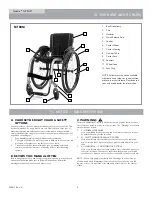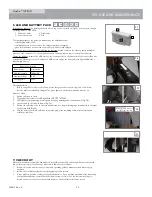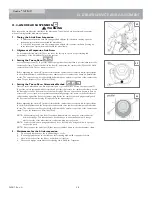
Quickie
®
NITRUM
249817 Rev. A
13
VII. WARNINGS: COMPONENTS & OPTIONS
G. OFFSET SEATING (Option)
WARNING
1.
A fore/aft change in the backrest position will aff ect the center of
balance of your chair.
2.
Only use this option when installing a forward off set mounted seating
solution, not using the standard back sling.
3.
Each time you adjust or modify the backrest plane location, the change
may make it easier to tip backwards. Use anti-tips until you adapt to the
change, and are sure you are not at risk to tip over.
If you fail to heed these warnings damage to your chair, a fall, tip-over or loss of
control may occur and cause severe injury to the rider or others.
H. POSITIONING BELTS (Option)
WARNING
The positioning belt is predominately used to support your posture. It can also
be used to limit slipping and/or sliding that you might experience when the chair
is in motion. The positioning belt is not a transit rated safety belt and should
not be used in the place of a seat belt while being transported in a motor
vehicle. Improper use of positioning belts may cause severe injury or death.
If you use a positioning belt, be sure to follow the recommendations in this
section:
1.
Make sure the rider does not slide down in the wheelchair seat. If this
occurs, the rider may suff er chest compression or suff ocate due to
pressure from the belts.
2.
The belts must be snug, but must not be so tight that they interfere with
breathing. You should be able to slide your open hand, fl at, between the
belt and the rider.
3.
A pelvic wedge or a similar device can help keep the rider from sliding
down in the seat. Consult with the rider’s doctor, nurse or therapist to
fi nd out if the rider needs such a device.
4.
Use positioning belts only with a rider who can cooperate. Make sure the
rider can easily remove the belts in an emergency.
5.
NEVER use positioning belts
a.
As a patient restraint. A restraint requires a doctor’s order.
b.
On a rider who is comatose or agitated.
c.
As a motor vehicle restraint. In an accident or sudden stop the
rider may be thrown from the chair. Wheelchair positioning belts
will not prevent this, and further injury may result from the belts or
straps.
If you fail to heed these warnings, damage to your chair, a fall, tip-over or loss of
control may occur and cause severe injury to the rider or others.
I. PUSH HANDLES (Option)
WARNING
When you have an attendant, make sure that this chair has push handles.
1.
Push handles provide secure points for an attendant to hold the rear of
this chair, to prevent a fall or tip-over.
2.
Check to make sure push handle grips will not rotate or slip off .
If you fail to heed these warnings damage to your chair, a fall, tip-over or loss of
control may occur and cause severe injury to the rider or others.
J. QUICK-RELEASE AXLES
WARNING
1.
Do not use this chair UNLESS you are sure that both quick-release rear
axles are locked.
2.
An axle is not locked until the quick-release button pops out fully.
3.
An unlocked axle may come off during use, resulting in a fall, tip-over or
loss of control and cause severe injury to the rider or others.
• Quick-Release Axles should be periodically cleaned and inspected for
function and signs of wear or bending. Replace as necessary.
If you fail to heed these warnings damage to your chair, a fall, tip-over or loss of
control may occur and cause severe injury to the rider or others.
K. REAR WHEELS
WARNING
A change in set-up of the rear wheels will aff ect the center of balance of your
chair.
1.
The farther you move the rear axles FORWARD, the more likely it is that
your chair will tip over backward.
2.
Consult your healthcare advisor to fi nd the best rear axle set-up for your
chair. Do not change the set-up UNLESS you consult your health-care
advisor fi rst.
3.
Adjust the rear wheel locks after you make any change to the rear axles.
a.
If you fail to do so, the wheel locks may not work.
b.
Make sure lock arms embed in the tires at least 1/8 inch when
locked.
If you fail to heed these warnings damage to your chair, a fall, tip-over or loss of
control may occur and cause severe injury to the rider or others.
L. REAR WHEEL LOCKS
WARNING
Rear wheel locks are NOT designed to slow or stop a moving wheelchair.
Use them only to keep the rear wheels from rolling when your chair is at a
complete stop.
1.
NEVER use rear wheel locks to try to slow or stop your chair when it is
moving. Doing so may cause a fall or tip-over.
2.
To keep the rear wheels from rolling, always set both rear wheel locks
when you transfer to or from your chair.
3.
Low pressure in a rear tire may cause the wheel lock on that side to slip
and may allow the wheel to turn when you do not expect it.
4.
Make sure lock arms embed in tires at least
1
/
8
inch when locked. If you fail
to do so, the locks may not work.
If you fail to heed these warnings damage to your chair, a fall, tip-over or loss of
control may occur and cause severe injury to the rider or others.
M. MODIFIED SEAT SYSTEMS
WARNING
Use of a seat system not approved by Sunrise may alter the center of balance of
this chair. This may cause the chair to tip over.
1.
Do not change the seat system of your chair UNLESS you consult your
authorized supplier fi rst.
2.
Use of a seating system not approved by Sunrise may aff ect the backrest
folding mechanism of this chair.
3.
Use of a seating system not provided by Sunrise is prohibited for transit
use.
If you fail to heed these warnings damage to your chair, a fall, tip-over or loss of
control may occur and cause severe injury to the rider or others.
Summary of Contents for Quickie Nitrum
Page 33: ...249817 Rev A 33 NOTES...
Page 34: ...249817 Rev A 34 NOTES...
Page 35: ...249817 Rev A 35 NOTES...













































